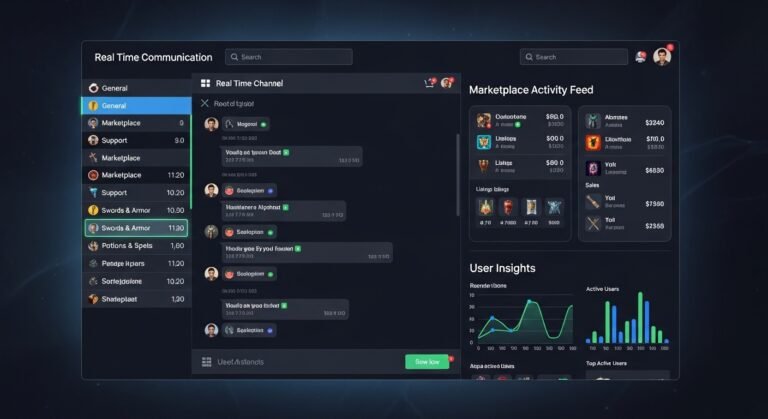The landscape of human resource management has transformed dramatically in the last decade. With digital tools redefining how we work, communicate, and manage people, businesses today require smarter, more flexible systems to support their workforce. Off-the-shelf HR software may offer convenience, but it rarely delivers the precision and adaptability growing enterprises need.
That’s why more organizations are turning to custom HR software development — tailored solutions that align perfectly with their business goals, workflows, and culture. In 2025, the HR function is no longer just about administration. It’s about strategy, analytics, and engagement — and custom HR software is the foundation enabling this transformation.
This comprehensive guide explores everything you need to know about custom HR software development — from its core components and benefits to emerging technologies and implementation best practices.
What Is Custom HR Software Development?
Custom HR software development refers to the process of designing and building a personalized human resource management system (HRMS) that caters to the unique needs of a business. Unlike pre-built tools that offer generic features, custom HR systems are tailored to an organization’s structure, compliance rules, and workforce dynamics.
These platforms can manage a wide range of HR operations — including recruitment, onboarding, payroll, performance tracking, and employee engagement — all within a single, integrated environment.
The key advantage lies in flexibility. Custom HR solutions evolve as your business grows, ensuring scalability, compliance, and seamless integration with other enterprise tools such as ERP, CRM, and financial management systems.
Why Businesses Are Moving Toward Custom HR Software in 2025
The year 2025 marks a significant shift in workforce trends. Organizations are adapting to hybrid work models, AI-driven decision-making, and heightened expectations for employee experience. Generic HR tools often fail to keep up with these fast-changing needs.
Here’s why custom HR software development is becoming the preferred choice for modern enterprises:
-
Evolving Workforce Models: Businesses now manage remote, hybrid, and global teams. Custom systems can accommodate varying compliance laws, time zones, and currencies.
-
Personalization Demand: Employees expect tailored experiences — from onboarding to training and career progression — which only custom systems can deliver.
-
Integration Requirements: HR systems must interact with numerous tools, from accounting software to project management platforms. Custom development ensures smooth data flow.
-
Data-Driven HR: Decision-making now relies heavily on analytics, predictive modeling, and real-time insights — capabilities that are built into modern custom HR software.
Ultimately, customization allows organizations to create a strategic HR ecosystem that aligns directly with their vision and goals.
Core Modules of a Custom HR System
A fully developed HR system covers every aspect of the employee lifecycle. Let’s break down its key components and how each contributes to workforce efficiency.
1. Recruitment and Applicant Tracking
A custom applicant tracking system (ATS) automates job postings, resume screening, and candidate evaluations. Advanced AI algorithms can even match candidates based on skill profiles and cultural fit, significantly reducing hiring time and improving quality.
2. Onboarding and Orientation
A personalized onboarding module ensures smooth transitions for new hires. It can automate form submissions, share welcome materials, and assign training sessions, ensuring that employees feel integrated and productive from day one.
3. Payroll and Compensation Management
Payroll accuracy is critical to employee satisfaction. Custom payroll systems automate calculations, deductions, and compliance with tax regulations, while integrating directly with attendance and timesheet data.
4. Attendance and Leave Management
Custom HR software can include biometric or digital attendance tracking, flexible leave configurations, and real-time synchronization with payroll systems — creating complete transparency.
5. Performance Management
Performance management modules enable continuous feedback, goal setting, and performance analytics. Instead of annual reviews, companies can track growth in real time and design personalized development plans.
6. Learning and Development
By integrating a Learning Management System (LMS), organizations can deliver online training, certification programs, and career development plans tailored to each employee’s goals.
7. Employee Engagement and Communication
Modern HR is about connection. A custom HR system can include chat tools, surveys, and recognition programs to strengthen engagement and company culture.
8. Compliance and Analytics
With labor laws and compliance requirements constantly changing, custom HR software includes configurable compliance frameworks and built-in analytics for better decision-making.
Together, these modules create a holistic HR ecosystem that supports every stage of the employee journey.
The Custom HR Software Development Process
Developing a tailored HR solution involves several structured stages. Each step ensures that the final product aligns with business needs and technical goals.
1. Discovery and Requirement Analysis
This is the foundation stage, where the development team collaborates with HR and business leaders to understand their unique challenges, processes, and goals. Clear documentation of requirements ensures that every feature delivers tangible value.
2. System Design and Architecture
At this stage, developers design the technical architecture — databases, integrations, and user flows. A strong focus is placed on scalability, security, and usability.
3. UI/UX Design
An intuitive interface enhances user adoption. Designers focus on accessibility, mobile compatibility, and streamlined navigation to ensure that both HR professionals and employees can use the platform effortlessly.
4. Development and Integration
Core features are built, tested, and integrated with existing systems such as ERP, accounting, and communication tools. APIs and middleware ensure seamless data exchange.
5. Testing and Quality Assurance
Comprehensive testing — including performance, usability, and security tests — ensures that the software performs reliably under real-world conditions.
6. Deployment and Training
The final product is deployed to the production environment. HR teams receive training and documentation to make the most of the platform’s capabilities.
7. Maintenance and Support
Post-deployment, ongoing support ensures smooth operation, periodic updates, and feature enhancements as business needs evolve.
This iterative development model ensures agility, enabling organizations to add or refine features over time.
Top Benefits of Custom HR Software Development
1. Seamless Integration
Custom HR solutions connect effortlessly with other enterprise tools, eliminating data silos and creating a unified digital ecosystem.
2. Improved Efficiency
Automation of repetitive processes frees HR teams from administrative workloads, allowing them to focus on strategic priorities.
3. Employee Empowerment
Self-service portals allow employees to manage their data, apply for leave, and access payslips — increasing transparency and satisfaction.
4. Enhanced Decision-Making
Advanced analytics and dashboards provide real-time insights into performance, attrition, and engagement, empowering HR leaders to make informed decisions.
5. Compliance and Security
Custom software can be built to comply with local and global labor laws while employing the highest security protocols to protect sensitive employee data.
6. Scalability
As businesses expand, new departments, features, and users can be added easily without disrupting existing operations.
7. Long-Term Cost Savings
While custom development has an upfront cost, it eliminates recurring licensing fees and inefficiencies, providing a strong ROI over time.
Emerging Trends in HR Software Development for 2025
As technology evolves, custom HR systems are integrating more advanced tools and capabilities. Here are the key trends shaping the future of HR software:
1. Artificial Intelligence (AI) and Machine Learning
AI is revolutionizing HR by automating candidate screening, predicting attrition risks, and recommending learning paths. Machine learning enables continuous system improvement based on real-time data.
2. Predictive Analytics
Organizations now use predictive models to forecast workforce trends — from hiring needs to engagement levels — enabling proactive HR strategies.
3. Cloud-Based HR Systems
Cloud architecture provides scalability, accessibility, and data security. It allows employees to access HR services anytime, anywhere — a must for hybrid and global teams.
4. Blockchain for Data Security
Blockchain technology ensures transparency and tamper-proof storage for employee credentials, payroll, and compliance data.
5. Mobile-First Experiences
With employees increasingly using smartphones for work, mobile-friendly HR interfaces enhance accessibility and engagement.
6. Employee Well-being Features
Modern HR systems now integrate mental health tracking, wellness programs, and digital counseling tools to support holistic employee well-being.
7. Integration of Chatbots
AI-powered chatbots streamline communication by handling common employee queries instantly — from leave balance to policy clarifications.
These innovations make HR systems not just operational tools, but strategic enablers of business transformation.
Challenges in Developing Custom HR Software
Despite the advantages, building a custom HR system comes with challenges that need proactive management:
-
Complex Requirements: Aligning diverse departmental needs requires detailed planning and consultation.
-
Data Migration: Moving legacy data into a new system can be complex and time-consuming.
-
Change Management: Employees may resist adopting a new system without proper training and support.
-
Compliance Risks: Global companies must account for varying labor laws and data protection regulations across regions.
Working with an experienced HR software development partner mitigates these risks through careful planning, testing, and user training.
How to Choose the Right Development Partner
Selecting the right partner is crucial for success. Look for a team that:
-
Has proven expertise in HR technology and enterprise systems.
-
Understands local and international compliance requirements.
-
Offers strong post-deployment support and scalability.
-
Provides transparent communication and agile project management.
The right partner doesn’t just build software — they build a strategic HR framework that aligns with your long-term vision.
The Future of Custom HR Software Development
As we move further into the era of automation and digital intelligence, HR technology will continue to evolve. The future of custom HR systems lies in hyper-personalization, AI-driven insights, and real-time employee engagement.
Businesses will increasingly rely on HR platforms that can predict workforce trends, adapt to new regulations instantly, and offer seamless digital experiences. The integration of AI, blockchain, and analytics will redefine HR as a data-rich, proactive function — not just an administrative necessity.
Conclusion
The year 2025 represents a turning point in human resource transformation. As businesses navigate complex workforce dynamics, custom HR software development has emerged as a critical enabler of efficiency, engagement, and innovation.
By designing HR systems that are flexible, data-driven, and employee-centric, organizations can build stronger, smarter, and more agile workforces. Whether it’s managing recruitment, payroll, or performance, custom solutions deliver exactly what your business needs — nothing more, nothing less.





